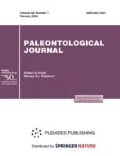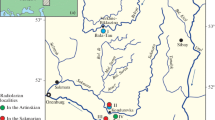Abstract
The phenomenon of giantism and minimalism in the skeleton of Late Paleozoic radiolarians is very unusually and has not yet been studied. However, this is not ugliness, but inherited morphological features, probably reflecting environmental influences and habitats. The analysis of 618 radiolarian skeletons has shown (1) inverse role of giant and small individuals in the Devonian (2% of giants and 11.7% of dwarfs) and Carboniferous–Permian (22.5% of giants and 2.2% of dwarfs); (2) a general trend toward increasing maximum conditional diameter of a conditional cell, which became 11 times greater, changing from 2% in the Devonian to 21.5% in the Carboniferous–Permian. This trend toward increasing size of skeletons and giantism in Late Paleozoic radiolarians could have indicated degeneration and reflected decline of radiolarians before mass extinction at the boundaries of the Devonian and Carboniferous (97.8% of species), Permian and Triassic (99.0% of species).







Similar content being viewed by others
REFERENCES
Afanasieva, M.S. and Amon, E.O., Radiolyarii (Radiolarians), Moscow: Paleontol. Inst. Ross. Akad. Nauk, 2006.
Afanasieva, M.S., Amon, E.O., Agarkov, Yu.V., and Boltovskoy, D.S., Radiolarians in the geological record, Paleontol. J., 2005, vol. 39, suppl. no. 3, pp. S135–S392.
Anderson, O.R., Radiolaria, Biochem. Physiol. Protozoa, 1980, vol. 10, no. 3, pp. 1–42.
Anderson, O.R., Radiolarian fine structure and silica deposition, in Silicon and Siliceous Structures in Biological Systems, Simpson, T.L. and Volcani, B.E., Eds., New York: Springer, 1981, pp. 347–380.
Anderson, O.R., Radiolaria, New York: Springer, 1983.
Barskov, I.S., Boiko, M.S., Konovalova, V.A., Leonova, T.B., and Nikolaeva, S.V., Cephalopods in the marine ecosystems of the Paleozoic, Paleontol. J., 2008, vol. 42, no. 11, pp. 1167–1284.
Cope, E.D., The Primary Factors of Organic Evolution, Chicago, IL: Open Court Publ., 1904.
Depéret, Ch., Les transformations du monde animal, Paris: Flammarion, 1907.
Depéret, Ch., Prevrashcheniya zhivotnago mira (Transformations of the Fauna), Borissiak, A., Ed., Petrograd: M. Stasyulevicha, 1915.
Klug, C., De Baets, K., Kroger, B., Bell, M.A., Korn, D., and Payne, J.L., Normal giants? Temporal and latitudinal shifts of Palaeozoic marine invertebrate gigantism and global change, Lethaia, 2015, vol. 48, pp. 267–288.
Maslakova, N.I., Gorbachik, T.N., Alekseev, A.S., Barskov, I.S., Golubev, S.N., Nazarov, B.B., and Petrushevskaya, M.G., Mikropaleontologiya: Uchebnik (Micropaleontology: Handbook), Moscow: Mosk. Gos. Univ., 1995.
Matsuoka, A., Skeletal growth of a spongiose radiolarian Dictyocoryne truncatum in laboratory culture, Mar. Micropalaeontol., 1992, no. 19, pp. 287–298.
Petrushevskaya, M.G., Radiolyarievyi analiz (Radiolarian Analysis), Leningrad: Nauka, 1986.
Sander, P.M. and Clauss, M., Sauropod gigantism, Science, 2008, vol. 322, pp. 200–201.
Vermeij, G.J., Gigantism and its implications for the history of life, PLoS ONE, 2016, vol. 11, no. 1, pp. 1–22.
ACKNOWLEDGMENTS
I am sincerely grateful to A.S. Alekseev for advisable discussion on the manuscript and valuable remarks and to G.S. Rautian for translation of the present paper into English.
This study was supported by the Program of the Presidium of the Russian Academy of Science “Evolution of the Organic World and Planetary Processes.”
Author information
Authors and Affiliations
Corresponding author
Additional information
Translated by G. Rautian
Rights and permissions
About this article
Cite this article
Afanasieva, M.S. Biotic Crises and Giantism of Radiolarian Skeletons in the Late Paleozoic. Paleontol. J. 52, 1701–1709 (2018). https://doi.org/10.1134/S0031030118140022
Received:
Published:
Issue Date:
DOI: https://doi.org/10.1134/S0031030118140022




